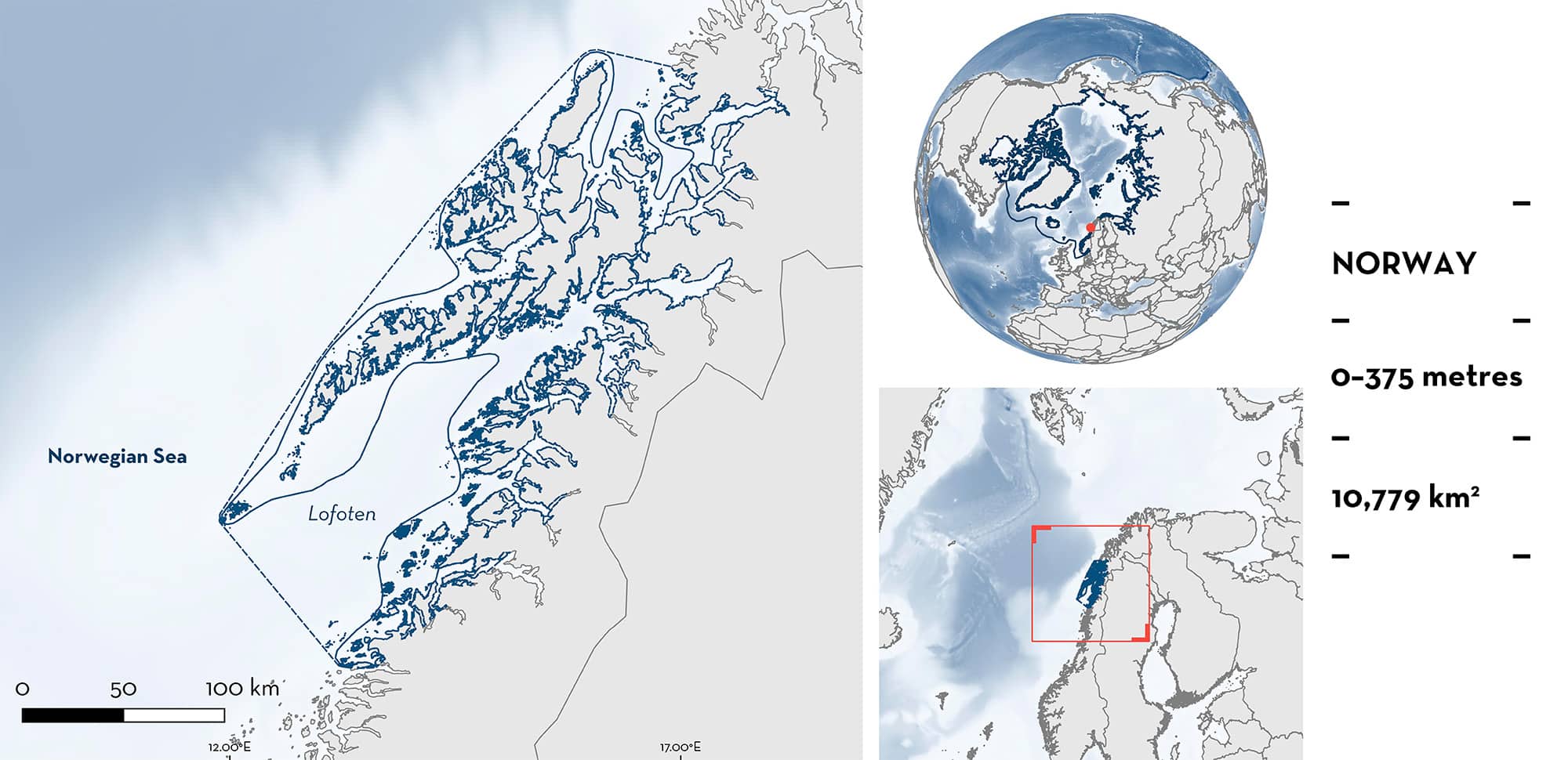ISRA FACTSHEETS
ISRA FACTSHEETS
POLAR WATERS REGION
Lofoten
Summary
Lofoten is located on the west coast of Norway encompassing Vestfjorden, Vesteralen, and Lofoten Islands. The area is characterised by a narrow continental shelf and a complex oceanography partially related to the atypical wide fjord opening of Vestfjorden. The area is influenced by two northward flowing currents, the North Atlantic Current and the Norwegian Costal Current. This area overlaps with one marine protected area, eight Key Biodiversity Areas, and nine Ramsar sites. Within this area there are: threatened species and feeding areas (Basking Shark Cetorhinus maximus).
Download factsheet
Lofoten
DESCRIPTION OF HABITAT
Lofoten is located on the west coast of Norway. The area encompasses the coastal parts of the Vestfjorden (including Lofoten Islands, Salten/Ofoten Island, and Vesteralen Island) and the south coast of Senja. The area is characterised by a complex oceanography partially related to the atypical wide fjord opening of Vestfjorden. The Lofoten Islands border Vestfjorden on its west side, connecting the inner water with the outer continental shelf through several straits and sounds (Espinasse et al. 2017). The Lofoten-Versteralen continental shelf is especially narrow (10–50 km) compared to the rest of the Norwegian west shelf (~250 km) (MAREANO 2015). The flow between Vestfjorden and the continental shelf is highly influenced by tidal forces, that when coupled with strong winds can generate very intense currents through the sounds and straits (Espinasse et al. 2017).
The area is dominated by two northward flowing currents: the North Atlantic Current (NAC) and the Norwegian Costal Current (NCC). The NCC is a low-salinity current that originates from the Baltic Sea and runs along the coast fed by freshwater runoff from the fjords. The NCC splits in two at the entrance of Vestfjorden, with a branch entering the fjord generating semi-permanent eddies, and another branch continuing north along the north coast of the Lofoten Archipelago (Espinasse et al. 2017; Sundby et al. 2013). The NAC is saltier and runs parallel to the west of NCC. The NAC is an extension of the Gulf Stream, transporting warm Atlantic water northward and promoting mild climates at these high latitudes (MAREANO 2015). The interaction of both currents promotes high productivity in the area and continuous advections have a significant effect on the plankton distribution around the Lofoten Islands (Espinasse et al. 2017).
The area is located north of Træna Trough, a large topographic feature that funnels the crustacean zooplankton copepod Calanus finmarchicus into the shelf on Lofoten. Copepods are an important food source for many pelagic fishes in the Norway Sea. Lofotone, located just upstream, is one the main spawning grounds for Northeast Arctic Cod Gadus morhua and Atlantic Herring Clupea harengus during the boreal spring, species highly dependent on copepod eggs and larvae as their primary prey during their first life stages (Opdal & Vikebø 2016).
The area partially overlaps with Kaldvågfjorden og Innhavet Marine Protected Area (UNEP-WCMC & IUCN 2024), and overlaps with Andøya (including Skogoll), Bleiksøy, Langøya, Lofoten, Nykvåg, Øksnes, Røst, and Værøy Key Biodiversity Areas (KBA 2024 a-h), and Anda, Bliksvaer, Grunnfjorden, Karlsøyvær, Laukvikøyene, Måstadfjellet, Risøysundet, Røstøyan, and Skogvoll Ramsar sites (Wetlands of International Importance) (Ramsar 2024 a-i).
This Important Shark and Ray Area is delineated from surface waters (0 m) to 375 m based on the bathymetry of the area.
CRITERION A
VULNERABILITY
One Qualifying Species considered threatened with extinction according to the IUCN Red List of Threatened Species regularly occurs in the area. The Basking Shark is assessed as Endangered (Rigby et al. 2021).
CRITERION C
SUB-CRITERION C2 – FEEDING AREAS
Lofoten is an important feeding area for one shark species.
The area is an important seasonal feeding site for Basking Shark during the summer. Based on citizen science reports since 2007, a total of 220 individual sightings of Basking Sharks were reported. Observations were made in 2007–2019 (n = 21), 2020 (n = 26), 2021 (n = 114), 2022 (n = 34), and 2023 (n = 25). The vast majority of sightings (97.3%) were reported between June and August, with more than half (54.1%) being reported in July (Institute of Marine Research 2024). Basking Sharks are reported swimming calmly on the surface, and in 31.4% of the sightings, feeding with observations of animals with their mouths open or swimming back and forth in the same area. Basking Sharks are selective filter-feeders, foraging in the most profitable zooplankton patches rich in copepods, including fish eggs and fish larvae (Matthews 1950; Sims & Quayle 1998). Lofoten is a highly productive area, with important plankton advection during spring, and hosts one of the main spawning grounds for Northeast Arctic Cod and Atlantic Herring (Opdal & Vikebø 2015; Espinasse et al 2017). This area comprises the highest sighting density of Basking Sharks in Norway, including 53.9% of the citizen science sightings reported between 2007–2024 nationwide (Institute of Marine Research 2024).
Download factsheet
SUBMIT A REQUEST
ISRA SPATIAL LAYER REQUEST
To make a request to download the ISRA Layer in either a GIS compatible Shapefile (.shp) or Google Earth compatible Keyhole Markup Language Zipped file (.kmz) please complete the following form. We will review your request and send the download details to you. We will endeavor to send you the requested files as soon as we can. However, please note that this is not an automated process, and before requests are responded to, they undergo internal review and authorization. As such, requests normally take 5–10 working days to process.
Should you have questions about the data or process, please do not hesitate to contact us.


